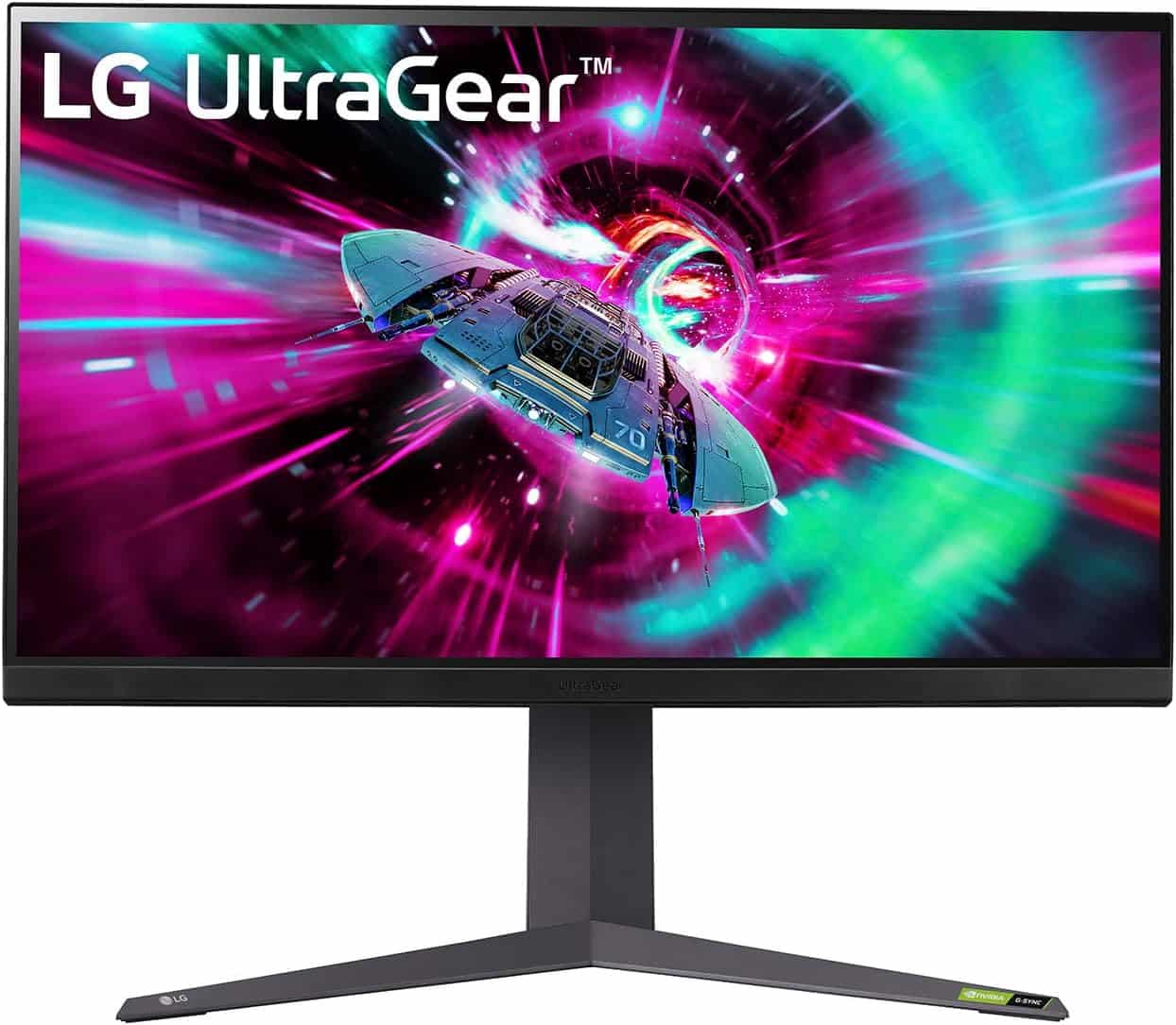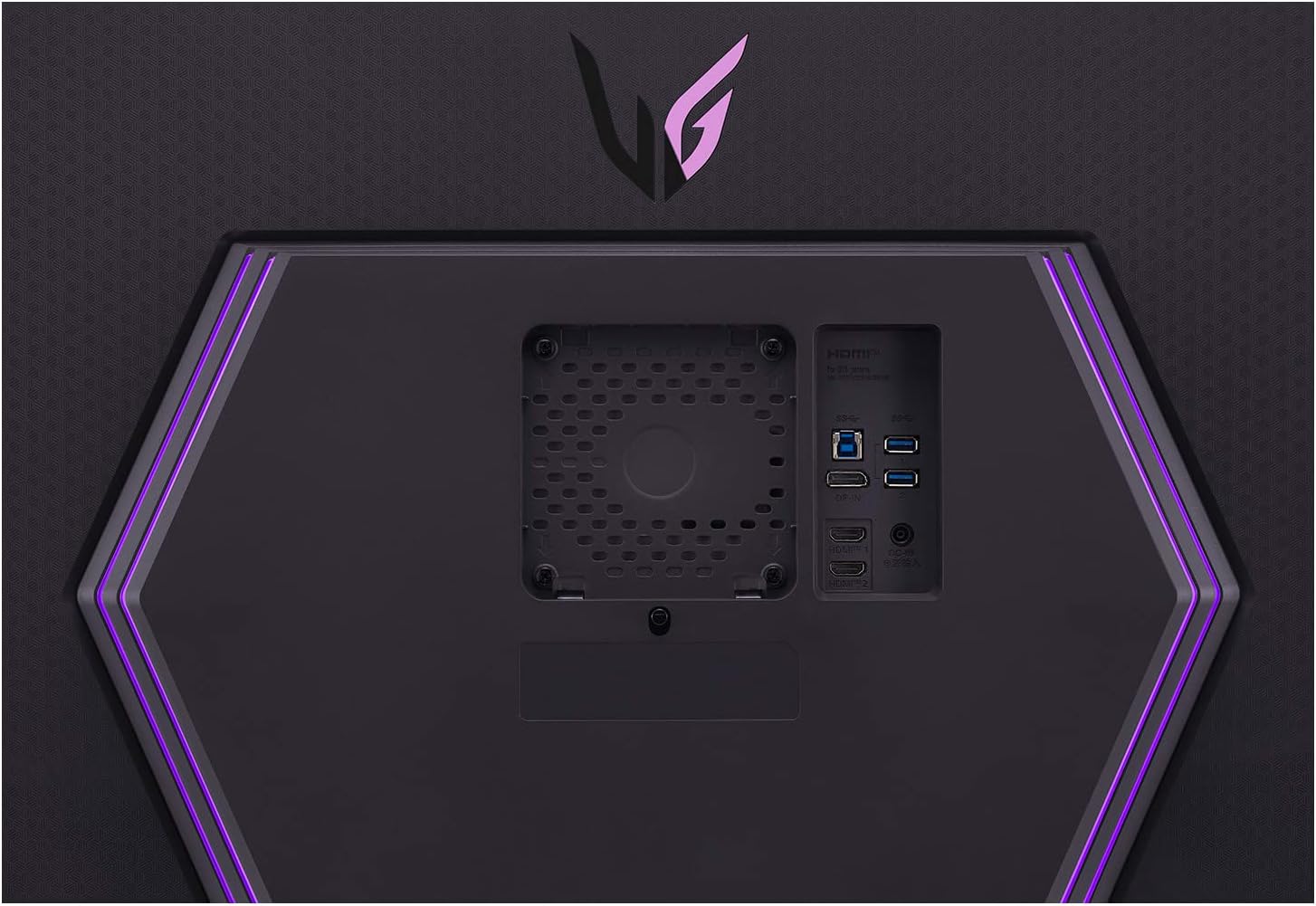The LG 32GR93U is a cheaper alternative to the impressive 32GQ950-B that doesn’t sacrifice raw gaming performance. It still has some of the bells and whistles, but stuff like the ATW Polarizer, higher HDR certification, and extra refresh headroom have been omitted. We’re okay with the losses if the price is more wallet-friendly, but we’d still like to see flagship-level numbers from its imaging and gaming qualities.
LG 32GR93U Specifications
- Screen Size: 32 Inches
- Resolution:3840 x 2160 UHD
- Aspect Ratio: 16:9
- Panel Technology: In-Plane Switching (IPS)
- Refresh Rate: 144Hz
- Response Time: 1ms
- Contrast Ratio: 1000:1
- Brightness: 400 cd/m2
- Built-in Speakers: None
- Stand: Height – Yes
- Stand: Tilt – Yes
- Stand: Swivel – No
- Stand: Pivot– Yes
- VESA Compatibility: Yes (100 x 100)
- Connectivity: DisplayPort 1.4 DSC x 1, HDMI 2.1 x 2, USB 3.0 x 2, 3.5mm Jack x 1
- Dimensions With Stand (WxHxD): 28.1″ x 24.1″ x 10.9″
- Weight: 18.3 lbs
Design and Features
The LG 32GR93U looks every bit like an UltraGear monitor, including the Hexagon Lighting feature at the back of the chassis. The monitor has a matte black chassis and the more discrete purple accents in some of its inconspicuous spots. The display has thin bezels on three sides, but it has inner borders and a thicker bottom strip.
It’s a larger monitor, so some of the smaller desks like those from IKEA might not be a good idea for it. The width can displace other large peripherals, so you have to consider its dimensions first before pulling the trigger. This model is lighter than the previous release, so its going to be easier to carry around for when rearranging your setup.
Its build quality is excellent and comparable with many premium offerings, so you aren’t losing much if you go with this cheaper pick. The plastics used are thick and sturdy, plus there were no cosmetic defects on any of its parts. There was some wobbling with the stand, which was unfortunate, but it was not entirely a deal breaker.
The LG 32GR93U has a joystick for the OSD under the UltraGear logo on the bottom bezel. You can also control it with LG’s OnScreen Control app, so there should be no difficulties if you want to tweak the screen often. It doesn’t have a remote, but that’s okay since it already comes with decent options.
The stand included with the package offers tilt, pivot, and height adjustments for your convenience. It is easy to get a comfortable viewing angle, so you can game for extended periods without worrying about straining your neck. You can use VESA mounts, but it’s only necessary in select instances, so we don’t recommend buying it immediately.
The LG 32GR93U isn’t the best when it comes to connectivity, particularly since it still doesn’t include USB-C for modern work laptops. It has DisplayPort 1.4 for your PC and two HDMI 2.1 consoles to accommodate the latest gaming consoles. It also has two USB 3.0 ports for accessories and a type-B upstream port.
It doesn’t have a 3.5mm port or a pair of built-in speakers, but that’s okay since the monitor deserves immersive headsets anyway. They will sound better and drown out unwanted noise, so you can enjoy your games and movies even more.
Display and Performance
The LG 32GR93U boasts a 32-inch IPS panel with a 3840 x 2160 resolution, a 144Hz refresh rate, and a 1ms boosted response time. The backlight has a 400 cd/m2 limit while the contrast is listed at 1000:1like most IPS screens. Its HDR certification dropped to HDR 400 compared to the 32GQ950-B’s HDR 1000, but that’s okay due to the lower price.
4K is more suited to a 32-inch display since the pixel density isn’t too concentrated. It’s a bit better to read, browse, and type with it even if you don’t use scaling, while that extra screen real estate looks even more appreciable. Games are still sharp and detailed, so you are not losing much compared with the 1080p alternatives.
The LG 32GR93U covers 100% of the sRGB and 98% of the DCI-P3 gamut for stunning color in games and movies. However, its default accuracy isn’t the best since the default accuracy had a deltaE average of 2.91. Wide gamut monitors are usually inaccurate out of the box but there are a few exceptions to the rule.
Calibrating the monitor improved its deltaE average to 0.93, making it more suitable for editing work and content creation. However, you will need a colorimeter to achieve this since copying ICC profiles or settings cannot guarantee it due to panel differences. We can only recommend it for professional use, but gamers will be fine with the default output.
The LG 32GR93U’s backlight reached 429 cd/m2 at 100% output, but it moved up a little to 445 cd/m2 when its HDR 400 capability was active. Its contrast reached 1151 cd/m2 at 30% brightness, so it’s a bit better than most IPS monitors in the market. It can’t produce deep blacks like VA or OLED monitors, but that’s a known limitation that’s associated with the panel type.
The screen’s uniformity was great since there were no backlight leaks on any of its edges. There was some variance in the backlight’s spread, but it wasn’t noticeable in common scenes or instances. Note that this can vary between every unit made due to tolerances, so there are better and worse ones out there.
The LG 32GR93U’s pixel response time is just as good as what the 32GQ950-B is capable of, so it’s also almost blur-free. It needs a bit of overdrive to achieve that, but the maximum level isn’t necessary since it will induce an overshoot. The monitor works great for fast-paced games, although there are some instances where persistence can show up.
The LG 32GR93U is compatible with FreeSync and G-Sync for tearing and stutter-free 4K gaming. It’s essential to have VRR while gaming at 4K since keeping frames steady with either AMD or Nvidia GPUs can be a challenge. Its input lag sits at 4ms at 144Hz, so it is just as fast as the best 4K 144Hz gaming monitors out there.
Thoughts on the LG 32GR93U
The LG 32GR93U is an excellent gaming monitor that doesn’t sacrifice gaming performance to help make its price a bit more reasonable. It doesn’t have the technical add-ons such as the ATW Polarizer or a more potent backlight implementation, but it’s capable of smooth visuals and rich colors. It is designed quite well, although it could use a more stable stand to make it even more perfect.
We don’t have a lot of issues with this monitor, although it could use a few tweaks from the factory. We’re used to better default accuracy results from LG, plus it should at least include a USB-C slot which we feel is standard for premium monitors. But it’s an excellent buy unless the cheaper Gigabyte M32U comes into play.
Pros:
- Fast 4K 144Hz
- Wide Gamut Coverage
- HDMI 2.1 Connectivity
Cons:
- Higher Price than Some Compelling Competitors
- Limited HDR and Contrast
- No USB-C
About the Author: 





Leave a Reply